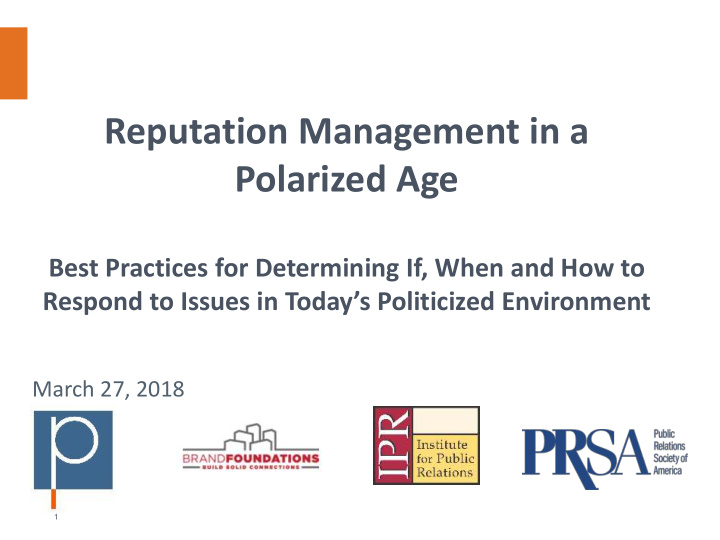



Reputation Management in a Polarized Age Best Practices for Determining If, When and How to Respond to Issues in Today’s Politicized Environment March 27, 2018 1
Intro Steve Cody JP Laqueur Co-Founder & CEO Chief Connector Peppercomm BrandFoundations 2
Overview of research I. Handling the new presidential administration – April 2017 II. Managing the digital age – September 2017 III. Responding to issues in today’s highly politicized environment – Spring 2018 3
The public expects corporate purpose • 47% of millennials believe CEOs have a responsibility to speak up about important social issues • 51% are more likely to buy from a company led by an activist CEO - KRC Research • 62% of employees of all ages expect their employer to take a stand on major issues of the day. - Glassdoor 4
The leadership vacuum and rise of CEO advocacy CEOs expected to step up and fill the leadership gaps existing in today’s society 5
Unintended consequences Oxford University and McDonald’s both had gaffes stemming from actions taken during International Women’s Day 6
Yesterday’s mistake can be today’s opportunity Organizations with past transgressions can fix what’s been broken 7
Taking a stand Delta Airlines CEO Ed Bastian stood his ground on a polemical issue "Our objective in removing any implied affiliation with the NRA was to remove Delta from this debate. While Delta's intent was to remain neutral, some elected officials in Georgia tied our decision to a pending jet fuel tax exemption, threatening to eliminate it unless we reversed course. Our decision was not made for economic gain and our values are not for sale ." 8
Peppercomm/IPR 2018 CCO/CMO study findings 9
Accepting Uncertainty • More emphasis around putting plans and procedures in place to handle any crisis as it happens • Is your brand immune to getting into potential debates with the presidential administration or government officials? 10
Rethinking Preparedness Plans for the Unexpected Crisis • Are you relying on traditional crisis plans? Or are you developing more sophisticated vetting procedures to evaluate when and how to respond? • CCOs/CMOs closely aligned with CEO on these matters • Respond to issues directly involving your business or actively look at social/political/cultural issues in the public sphere? 11
The changing face of employee communication • Increasingly expecting and pressing leaders to take a stand on issues and events • Many brands feel more comfortable taking a stand with employees rather than publically • Many rely on employee resource groups (such as LGBT, black, women’s groups) to communicate and build programming on related issues 12
Responding with the truth • Fact-finding is essential (clarify misinformation) • Consistency across all channels, one set of messages • To get the truth out, consider telling your story through a beat reporter familiar with your brand/industry. 13
Working through government relations • How would you rate your relationship with your colleagues on the hill? How does it inform your communications strategy? • Many communicators rely on their government relations colleagues to identify key issues and arrive at mutually beneficial decisions. • Lobbyists may fight the fight, but communications pros must be prepared to issue their stance as well. 14
Team-oriented approach To avoid a chain reaction of events that could affect the brand, one major airline brand put a team together to: 1. Monitor social media for conversations on relevant issues that may be gaining traction 2. Meet monthly to discuss issues and whether to engage, using purpose as a guide and North Star 3. Account for every constituent who may be affected or agree/disagree with your stand 4. Scenario plan the different outcomes to see the benefits or consequences of each decision 15
Measuring the effects and impact of a crisis 16
No Greater Downside Risk Lost CEO Lost CEO Recruiting? #DeleteUber = $2B in costs Alumni giving? 200K lost users in 6 days! 17
But also no greater upside… Avg. increase of 19% in operating income, 28% growth in earnings-per-share 300% more creative, 31% more productive, 37% greater sales Companies with a strong brand purpose and aligned culture outperformed the rest of the S&P 500 by ~400% over ten years and Up to 50% less turnover, profits increase 12x, 4x cumulative stock market returns two recessions! 18
Tangible Value in Intangible Assets Percentage Allocation of Purchase Price to Goodwill By Industry 19
Understanding Stakeholders 20
Remember: It’s Not Just About You… 21
Know the Character of Your Audience 22
Communicating with Purpose 23
Move Beyond Mission, Vision & Values… Undifferentiated (e.g. “Integrity”) WW2 era mentality (“mission”) fails to inspire Millennial generation (“Purpose”) Unclear how they relate to one another (mission vs vision?) Often ignored, sometimes ridiculed 24
A Better Model: Purpose-Way- Impact 25
Purpose Defined These four brands embody what it means to have a premiere corporate purpose 26
Tell a Story Example: “A small group of powerful interests have aligned to rig the system and perpetuate We’re genetically wired for their power at the expense of ordinary people.” storytelling Our brains are more active when we are reading or hearing a story We can recall (and retell) stories better than facts Bad Guys: Bad Guys: Wall Street Washington 27
Put it in Writing… & Celebrate it 28
Questions & Comments 29
Recommend
More recommend